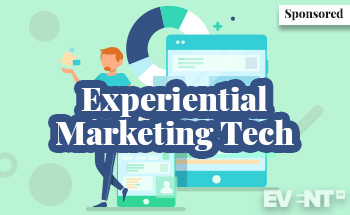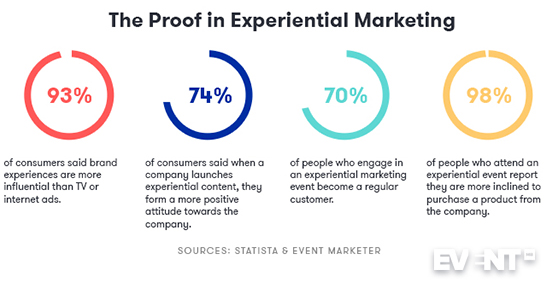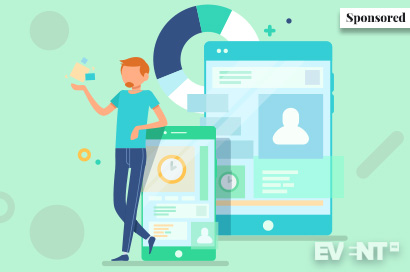Skift Take
Arguably, one of the hottest job areas today in the meetings and event industry is experiential marketing. Over the last few years, meeting and event companies have begun to focus on experiential marketing campaigns to create engaging, branded content to drive the audience-brand relationship.


More and more experiential marketing jobs are popping up to launch experience-based marketing activations and experience of such campaigns are becoming essential. But despite all the chatter around experiential marketing, there’s doesn’t seem to be a lot of discussion or resources for planners to help them take a leap into this new world. In this post, we will break down experiential marketing for today’s planners, as well as show how they can use technology (some of which they may be already be using at their events) to make the transition from experience to experiential.
What is Experiential Marketing?
Since experiential marketing is a fairly new field, it is important to clearly define what experiential marketing is.
Experiential marketing is an authentic, branded engagement between a customer and a company.
In other words, experiential marketing is a two-way-channel of communication between customers and a brand. Experiential marketing advertises a brand to a customer in an interactive and engaging way.
Over the last few years, companies have shifted away from traditional marketing, where brands would advertise and communicate with their customers via a one-way-channel. Experiential marketing has become more of a mainstay in the marketing and the event world.
Although experiential marketing was once seen as an “add-on” that companies or brands implemented to gain more buzz around their product or event, many organizations are now adding experiential marketing roles or departments into their companies. Specifically, companies like Amazon, American Express, Dunkin Donuts, Gatorade, and Marriott, have successfully incorporated experiential marketer roles and exciting campaigns.
Despite all the chatter around experiential marketing, no one is discussing the tools experiential markets use or should be using. Where is the technology for experiential marketers?
Is There Real Value in Experiential Marketing?
Thanks to the age of technology we live in and all the ads thrown at people, consumers are no longer impressed or engaged by print ads or TV commercials. In fact, research has shown that people generally only remember ten percent of what they read (like advertisements), but ninety percent of what they do. The “do” is where experiential marketing comes in.
Experiential marketing allows your consumers to “do” or experience something, in relation to your brand, and form an emotional connection. Creating an emotional connection between your target audience and brand has been shown to increase consumer loyalty.
Examples of experiential marketing to inspire you:
- A Snapchat scavenger hunt. The telecommunications company Verizon recently launched a Snapchat scavenger hunt for its customers where people have to find, catch, and mix loops that appear to win an iPhone XS.
- A hashtag campaign. As part of the Lean Cuisine’s #WeighThis campaign, Lean Cuisine set up chalkboards, shaped like scales, in New York’s Grand Central Station and had women write how they actually wanted to be “weighed in”.
- User-generated content. Back in 2016, Starbucks asked their customers to share their holiday cup doodle designs on Instagram. They then chose thirteen designs from six countries to be used for the entire holiday season.


By creating experiential marketing campaigns on social media or by hosting events, you can increase your target audience’s relationship with your company or product.
Have You Got What It Takes For An Experiential Marketing Role?
After reviewing global experiential marketing job postings, we gathered some data to create a profile of the characteristics experiential event marketers will need to succeed.
Demographics
- An experiential marketer’s title tends to include phrases like, “Experiential Producer”; “Marketing Manager- Events & Experiential”; “Manager, Special Events”, and, “Senior Production Manager, Special Events”.
- Experiential marketers, on average, tend to be female and age from 26 to 38 years old.
- An experiential marketer tends to have a college education in new media or design, marketing, and/or communications.
Priorities
- An experiential marketer prioritizes delivering beyond the ordinary event expectations.
- Experiential marketers create unique, personalized experiences for every attendee.
- Experiential marketers also manage on-site execution of events including vendor load-in, event flow, and load-out.
- An experiential marketer also creates an authentic social network.
Goals
- Experiential marketers aim to create shareable experiences.
- An experiential marketer intends to build brand awareness amongst their target audience.
- Experiential marketers want to create meaningful connections between the brand and community members.
- An experiential marketer also tries to tell their client’s story.
Metrics
- An experiential marketer measures success by attendee satisfaction survey scores.
- Experiential marketers also determine an experiential campaign’s success by the number of leads generated.
- An experiential marketer also measures their campaign by 360-degree success—did everyone (attendees, developers, speakers, etc.) enjoy the event?
Challenges
- Experiential marketers tend to face challenges in creating a unified brand experience across all channels.
- An experiential marketer aims to tailor communication to specific demographics.
- Experiential marketers need to think on their feet and problem-solve issues on-site (e.g. long check-in lines; walk-up registrations).
How Do Experiential Marketers View Events?
- Knowing that events are not just about the logistics and numbers, an experiential marketer may describe events as “a strategic part of a business. Learn more about all marketing channels and how events can complement those efforts. Think of what you do as creating experiences—not events”
An experiential marketer’s role is to provide customers with authentic experiences related to a product or company. In a way, experiential marketing is a form of immersive storytelling, focused on a brand or product’s story.
What Experiential Marketing Technology Is Out There?
In the beginning of experiential marketing, companies would hold sampling shows or events to directly engage the consumers. More specifically, these companies would allow their customers to sample their products, at no or deeply discounted costs, in hopes that their sampling would lead to brand interest and a future purchase.
Thanks to technological innovations in experiential marketing, companies can now use technology to reach consumers or event attendees and digitally implement their experiential marketing campaigns. Experiential marketing technology can also be used to solve some of the challenges listed above.
Email Marketing Products
Experiential marketers can use email marketing products to effectively market and promote email marketing campaigns to promote their experiential event.
- An email marketing product can help experiential marketers target and connect with the right target audience, by creating groups or email lists of ideal attendees. Marketers can also foster relationships with their audiences in the days and weeks leading up to the event through targeted emails complete with reminders, links to articles or stories and so much more.
- An experiential marketer can also use an email marketing product to shape an attendee’s event expectations before they even register or arrive, by tying in a campaign’s branding elements to get attendees excited and talking about your event. If your campaign has a hashtag, an email can encourage attendees to start using it. If your event is about raising money, an email can encourage attendees to donate. The possibilities with email are endless.
Mobile Event Apps
With over 5 billion people using mobile smartphones, experiential marketers can use mobile event apps to help promote their experiential campaigns or events.
- Experiential marketers can create branded event apps to provide a targeted, personalized experience for their attendees.
- Some of these apps can provide personalized agendas, in-app event information, allow attendees to share content, and give attendees access to the event’s social media feed before, during, and after the event.
- Best of all, an app also gives marketers the power to send push notifications that can issue reminders, event information changes, and more, throughout the event experience.
Event Registration Apps
Since registration tends to be an attendee’s first experience with an experiential marketers’ event, it is important for you to provide attendees with a good first impression.
- Event registration apps allow experiential marketers to provide attendees with a personalized online registration.
- Using registration products, experiential marketers can create a branded registration workflow to collect specific attendee data that will be critical for the experiential campaign analytics.
- Marketers can also create personalized registration paths depending on the type of attendee. For example, VIPs might have more special options or discounts open to them throughout registration, or an average attendee registration step can encourage them to buy add-on experiences or packages.
Surveys and Polling Products
Experiential marketers can use the survey and polling feature offered in some mobile event apps, to capture their attendees’ reactions before, during, and after the experiential event.
- Experiential marketers can use survey and polling information to gain real-time feedback from attendees on the speakers, sessions, or other activities at the experiential event.
- Experiential marketers can also advertise the survey and polling feature to their attendees. By asking for attendee’s feedback, experiential marketers show attendees that they care about their opinions.
Wearables
Wearables have become essential for event planners, and now for experiential marketers too.
- As an experiential marketer, in real-time, you can assess your experiential campaigns’ ROI by studying where attendees engage at your event.
- For attendees, they can use wearables to digitally share their contact information with other attendees. All they have to do is sync the event’s mobile app with their wearable and the app will track and save the connects they make.
- Wearables like smart tags also have the ability to enhance gamification at events. As they can track where attendees are, they are the perfect devices for things like scavenger hunts, races or earning digital badges.
Event Goal and Analytic Products
Some event management software products can help experiential marketers identify what their customers, or event attendees, value.
- Using an event goal and analytic product, experiential marketers can study attendee’s reactions to their events by naming the most influential speakers and exhibitors at an event. This information can then be applied to future events to create the same, unforgettable experience.
- Experiential marketers can also use event goal and analytic products to customize their reporting to best measure the ROI that an experiential event or campaign has on their business KPIs.
- This data can also be leveraged to make sure experiential marketers are providing individuals with a unique experience.
Experiential marketing technology not only incorporates the most traditional technology tools, emerging technology trends are also used.
Virtual Reality (VR)
Virtual reality, a computerized environment where users can interact with specific content in a three-dimensional manner, can be used by experiential marketers.
- Experiential marketers can use virtual reality technology to add that extra “wow” factor to your experiential events. Virtual reality technology can make your event more engaging and memorable for attendees.
- Planners can also create virtual reality information booths where attendees can find answers to common questions regarding a product or your promotion. Just input the questions and answers you think attendees may ask and let them explore the virtual information booth.
- Instead of hosting an in-person event, experiential marketers can also use VR technology to host a digital event. Doing this, you can reach a wider audience and cut venue costs.
Live Streaming
Live streaming, like Facebook Live, can also be used by experiential marketers to build brand awareness and attract more attendees.
- Experiential marketers can use live streaming technology to stream parts of their experiential event. Sharing live event footage can help create a brand or event’s authenticity, something experimental markets strive to achieve.
- Live streaming also allows experiential marketers to share their experiential event with a much wider audience, by sharing the video on all the company’s social media platforms.
- Broadcasting your event on Facebook, Twitter, Instagram or Periscope also helps ramp up that FOMO (or fear of missing out) factor, which gets people talking about your event for months or years to come. Consider live streaming not only your event but also behind the scenes or exclusive content, like interviews or Q&As, to drum up even more excitement.
Facial Recognition Technology
Facial recognition technology should be added to experiential marketer’s toolkit.
- Experiential marketers can use facial recognition technology in their experiential event, as it presents many opportunities for experiential marketers. Using this technology, they can connect with their audience in so many new ways.
- This technology can be used at check-in, for security purposes, measure traffic and even measure how individuals are feeling at events. All of this can be tied into experiential experiences.
- For example, a South African coffee company named, Douwe Egberts, launched a Bye Bye Red Eye experiential campaign in an airport. The company set up a coffee vending machine and used facial recognition technology to detect when people yawned. Seconds after they yawned, the person received a free cup of coffee.
IN CONCLUSION
The uses of event management and event industry technology are not limited to traditional events. Experiential marketers can use the event industry’s best technologies, like mobile event apps, email marketing products, and wearables to further communicate with consumers, making the connection between the customer and the brand stronger.
Also, adding in-house experiential marketing teams and services is critical. Experiential marketers need to be integrated with product and event campaign development. Doing this will help ensure that the company’s story and long-term brand strategy will be advertised in a meaningful, relatable way to the target audience.






